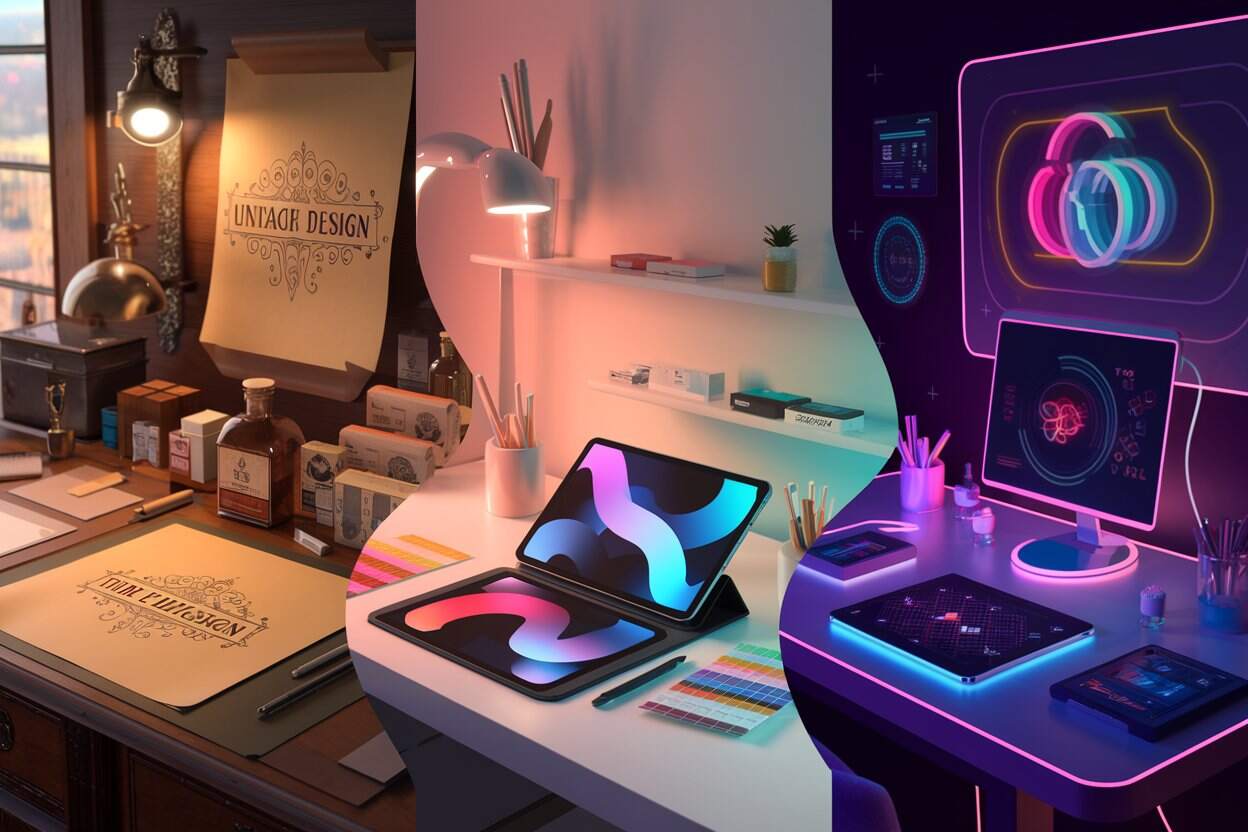The Evolution of Design: How Trends Shape Brands Over Time
Design is not static—it evolves alongside culture, technology, and consumer preferences. This blog delves into the fascinating journey of design trends and their influence on branding. Discover how iconic brands have adapted their designs over the decades, the impact of technological advancements, and the role of cultural shifts in shaping design aesthetics. Packed with insights, case studies, and actionable takeaways, this comprehensive guide helps businesses understand the power of evolving design to create timeless, relevant, and impactful brands.

Introduction: The Ever-Changing World of Design
Design is a living entity that evolves with time, influenced by cultural movements, technological advancements, and shifts in consumer behavior. From minimalist aesthetics to bold, experimental styles, each design era leaves its mark on branding. Understanding these trends and their impact is crucial for businesses aiming to create timeless yet relevant brands.
In this blog, we’ll explore the evolution of design trends, their impact on brands, and how businesses can leverage these shifts to stay ahead in an ever-changing landscape.
The Role of Design in Branding
Before diving into specific trends, it’s essential to understand why design matters in branding. Design is the visual language that communicates a brand’s identity, values, and promise to its audience.
• First Impressions: Design creates the initial connection with customers, shaping their perception of the brand.
• Emotional Connection: Visual elements evoke emotions, influencing how consumers relate to a brand.
• Recognition: Consistent design elements like logos, typography, and colors build brand recognition.
The Early Days: Simplicity and Functionality
In the early 20th century, design was heavily influenced by functionality. Brands like Coca-Cola and Ford focused on clear, legible logos that emphasized their products’ reliability and quality.
Key Features of Early Design Trends
• Simple typography and bold lettering.
• Limited color palettes for practicality in printing.
• Emphasis on utility and clear communication.
Case Study: Coca-Cola
Coca-Cola’s script logo, introduced in 1887, remains a classic example of timeless design. Its curvaceous font and distinct style have evolved subtly but never lost their original essence, making it one of the most recognizable logos worldwide.
The Rise of Modernism: Clean and Minimal
The mid-20th century saw the rise of modernism, emphasizing clean lines, minimalism, and functionality. This era was influenced by movements like Bauhaus and Swiss design, which prioritized clarity and simplicity.
Key Features of Modernist Design
• Use of sans-serif fonts for a clean look.
• Grid-based layouts for structure.
• A focus on functionality over ornamentation.
Impact on Branding
Modernism brought clarity to branding, with logos like IBM and Helvetica typography becoming synonymous with professionalism and innovation.
The 80s and 90s: Bold and Experimental
The 1980s and 1990s were all about breaking the rules. Bright colors, playful typography, and experimental layouts dominated the design landscape.
Key Features of 80s and 90s Design
• Neon colors and gradients.
• Unconventional typography styles.
• The use of abstract shapes and patterns.
Case Study: MTV
MTV’s logo, introduced in 1981, epitomized the experimental spirit of the era. The design was dynamic, with ever-changing patterns and colors, reflecting the brand’s youthful and rebellious identity.
The Digital Revolution: Interactive and Dynamic
The late 1990s and early 2000s marked the digital revolution, where design moved from static to interactive. Websites, apps, and digital ads became the new canvas for designers.
Key Features of Digital Design
• Responsive layouts for various devices.
• Animated graphics and dynamic content.
• The integration of user experience (UX) design principles.
Impact on Branding
Brands embraced digital-first strategies, creating logos and visuals that worked seamlessly across platforms. Companies like Google and Amazon adapted their designs to remain versatile and user-friendly.
Minimalism Reimagined: Flat and Clean
The 2010s saw a resurgence of minimalism, often referred to as “flat design.” Inspired by the digital age, this trend focused on clean, two-dimensional visuals.
Key Features of Flat Design
• Simple color schemes and gradients.
• Minimal use of shadows and textures.
• Emphasis on clarity and functionality.
Case Study: Apple
Apple’s shift to flat design in its iOS interfaces set a global trend. The clean and modern aesthetic reinforced its brand image as innovative and forward-thinking.
Current Trends: Bold and Purpose-Driven
Today’s design trends are influenced by social, environmental, and technological shifts. Brands are leveraging design to make bold statements and connect with conscious consumers.
Key Features of Current Trends
• Vibrant, bold color palettes.
• Inclusive and diverse visuals.
• Sustainable packaging and design practices.
Case Study: Patagonia
Patagonia’s eco-friendly branding extends to its design choices, reflecting its commitment to sustainability and environmental advocacy.
Lessons for Businesses: Adapting to Design Trends
1. Stay True to Your Brand Identity
• While adapting to trends, ensure your design reflects your brand’s core values and mission.
2. Balance Timelessness and Relevance
• Strive for designs that are both trendy and enduring, avoiding overly dated elements.
3. Leverage Technology
• Utilize tools and platforms that enable dynamic and interactive designs to engage modern audiences.
The Future of Design: What’s Next?
As technology and culture continue to evolve, so will design. Here are some emerging trends to watch:
• AI-Driven Design: AI tools are enabling hyper-personalized and automated design solutions.
• Sustainability Focus: Brands are prioritizing eco-friendly materials and visuals.
• Immersive Experiences: AR and VR are creating new dimensions for interactive and experiential design.
Conclusion: The Power of Evolving Design
The evolution of design is a reflection of society’s changing needs, tastes, and technologies. For brands, staying attuned to design trends isn’t just about aesthetics—it’s about staying relevant and resonant in an ever-changing world.
By understanding the past, adapting to the present, and preparing for the future, businesses can leverage design as a powerful tool to shape their brand and connect with their audience in meaningful ways.






